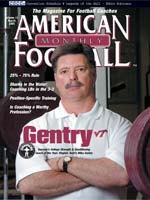AMERICAN FOOTBALL MONTHLY THE #1 RESOURCE FOR FOOTBALL COACHES
Article CategoriesAFM Magazine
|
Sharks In The WaterCoaching Linebackers to Attack in the 3-3 Defenseby: Ron Roberts © More from this issue We base out of our 3-3 Stack Defense. In Diagram 1 you will see that we have a Nose in a zero technique. Our Ends are in a tight 5 technique. The Mike linebacker is stacked behind the Nose and is responsible for running the track of the FB. The L and R are in 50 techniques and are responsible for B gaps. The Nitro and Diamond are 3 by 5 off the TE or a ghost TE. This is our pressure package and we want the offense to have to account for blocking all 5 mobile defenders on every snap. We are usually in some form of 3 deep zone, man free or Robber coverage. The possible blitzes are only limited by what you can execute and your imagination. This Defense fits our recruiting pool and allows us to put more speed on the field. (See Diagram 1) ....The full article can only be seen by subscribers. Subscribe today!
|
|
|||||||
| HOME |
MAGAZINE |
SUBSCRIBE | ONLINE COLUMNISTS | COACHING VIDEOS |
Copyright 2025, AmericanFootballMonthly.com
All Rights Reserved





